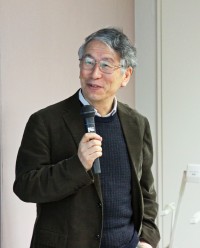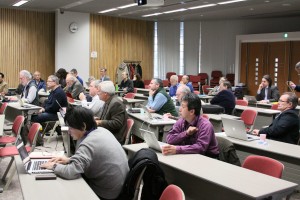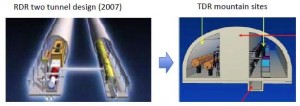
Atsuto Suzuki, KEK director general, addresses the superconducting radiofrequency Baseline Technical Review. Image: ILC
The final preparatory step in our process of defining the baseline for the Technical Design Report (TDR) is to carry out a set of four Baseline Technical Reviews (BTR) that concentrate on the large number of small technical decisions that remain to be defined for the TDR baseline. We previously made a set of top-level changes from the ILC reference design through a formal change process in order to better optimise performance, cost and risk. The large number of remaining smaller technical decisions is the responsibility of the Global Design Effort (GDE) project managers, who are leading a set of four open BTR meetings to help draw a consensus.
The first BTR was focussed on the positron source and damping rings, while the second was on accelerator systems. The third BTR, focussed on ILC main linac and superconducting radiofrequency (SRF) systems, was held at KEK on 19 and 20 January in order to define the outstanding issues for our central technology. The main linac is a primary cost driver for the ILC, therefore these technical decisions must be made with a strong eye on cost impacts.
The approach of the GDE project managers towards these decisions has been to first evaluate designs for technical feasibility and performance that satisfy the ILC technical requirements, make sure they are consistent with plug-compatibility at interfaces, and then make the most cost-effective design choices for the TDR baseline.
Some of the more important technical decisions for the KEK BTR included the following:
- In the area of main linac integration, there was a question of whether an extra 400 metres of tunnel (with or without utilities) should be included in the TDR baseline. The purpose would be to ensure that the capability of reaching 500 GeV was maintained, a measure that comes with consequences in timing issues and costs. This issue was analysed and discussed at length at the BTR meeting, leading to a decision to increase the length by only about 150 metres and to instrument the tunnel to increase the energy safety margin by at least 1 percent for both proposed high-level RF schemes.
- A new question addressed whether the main linac design could accommodate a slight tilt. This is a site-dependent issue regarding future expansion of the tunnel to 50 kilometres for the 1-TeV option. In order to cross a river for the Japanese southern site, the main linac must either be sited deeper (significantly increasing the required lengths of access tunnels), or a slight tilt must be accommodated. Technically, the proposed tilt does not appear to introduce any serious problems.
- The high-level RF being considered for mountainous sites has been a distributed system consisting of about four thousand 800-kilowatt klystrons. However, based primarily on cost considerations, a new tunnel shape (“kamaboko”) has been proposed that is capable of accommodating the original reference design high-level RF system. This tunnel concept has a shielding wall between the main linac and klystron gallery that would enable servicing as in the original two-tunnel scheme.
- The cryomodule configuration in the reference design consisted of three cryomodule sets containing a cryomodule with nine cavities, followed by one with eight cavities plus a quadrupole in the middle, followed again by a third with nine cavities. Alternatives to this configuration have been being considered, but the final conclusion is to stay with the RDR configuration.
- For cavity performance, a new recipe has been adopted: (1st pass: 60% and 2nd pass: 70%) having a gradient of 31.5 megavolts per metre +/- 20%, while adopting a statistical approach to cavity degradation.

Atsuto Suzuki, KEK director general, addresses the superconducting radiofrequency Baseline Technical Review. Image: ILC

A new tunnel shape for mountainous sites. The enabling reference design high-level RF concept has been adopted
Overall, the Baseline Technical Review process for completing the details of the TDR baseline has been working well and we are proceeding on schedule. We will carry out a final BTR, focused mainly on the conventional facilities, on 22 and 23 March at CERN.
I should make one important caveat as to whether we are truly finalising all aspects of the TDR baseline by the BTR process. We do not yet have detailed costing for the TDR subsystems, so the present decisions are based on our best present estimates of the cost impacts. We do not expect big surprises, but some adjustments in the design may be necessary once we are able to make reliable evaluations of the TDR costs over the coming months.


We have received an SBIR Phase I gtant for an Annular Beam 10 MW Klystron for the ILC. A Phase II proposal is fue in April – we are at present at 68% efficiency with the dimensions almost identical to the 6 beam MBK. \
When did the 800 kW klystron become a consideration??? We are also working on an SBIR Phase I grant for a 500 kW Permenet Magnet Focused klystron at 1.3 GHz for Project X at Fermi Lab. A simple scaling to 800 kW can be considered.
We are also presnetly working on an SBIR Phase II grant to develop a high efficiency (70%) Permanene Magnet Focused 10 kW CW klystron for the upgrade to APS at Argonne Lab. Expect to be on test this fall.